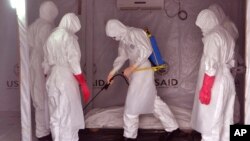The World Health Organization reports the Ebola epidemic in West Africa is slowing down and stabilizing in some places, but is far from over.
The World Health Organization reports two United Nations targets have been partially met; to get 70 percent of Ebola-infected people into treatment, and to have 70 percent of fatalities safely buried by December 1.
WHO officials think more than 70 percent of those ill with Ebola are in treatment in Liberia and Guinea. However, the WHO notes Sierra Leone falls short of this goal. It says the 70 percent target is probably being met in most places, but a number of hot spots remain in the western part of the country. It says another few weeks will be needed before the 70 percent target is met.
WHO Assistant Director-General Bruce Aylward said there was some good news on the second goal.
“In all three countries, it is clear now that more than 70 percent of the Ebola deaths that we know about are buried safely. This is because in the past 60 days, the number of safe burial teams has more than doubled from probably less than 100 or thereabouts to nearly 200 or just over. I think we are squeaking at 202 today across the three countries,” he said.
While significant progress has been made toward the 70-70 goal, Aylward said that was not good enough to stop Ebola. He called it an important milestone along the way. But, eventually, he said, the three Ebola-stricken countries must reach 100-percent treatment and safe burials.
He said these actions would have to be complemented with more intense surveillance measures. He said it was critical to trace every person who has had contact with an Ebola victim and break the chain of transmission before the epidemic can be ended.
“As the disease is falling like this, the actual number of people you are going to need and the geography that you are going to need to get to zero is actually going to increase…Now, you are going to have to have surveillance teams in every single district, every single county, every single prefecture to be able to find any remaining viruses, to be able to find the contacts of those cases and to be able to systematically really turn the tables on this virus and hunt the virus rather than being hunted by it,” Aylward said.
He said about 20,000 local monitors will be needed to trace all those who have been in contact with an infected person. Aylward added that the World Health Organization would deploy around 400 people to every county to help train these people.
He said the U.N. planned an intense six-month effort to try to get Ebola cases down to zero. And, then, he said at least 42 days would have to pass without any new cases before the epidemic can be declared over.
